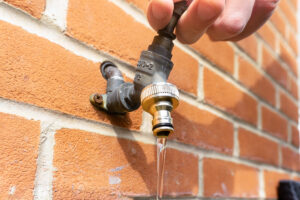
Preparing your plumbing for spring can ensure that everything is in proper working order as the seasons begin to change.
As winter fades away and spring blossoms, it’s the perfect time to ensure your plumbing is in top shape for the warmer months ahead. Seasonal changes can impact your pipes, fixtures, and overall plumbing system, so a little proactive maintenance can go a long way in preventing costly repairs.
Inspect for Leaks and Cracks
Cold winter temperatures can cause pipes to contract and expand, potentially leading to cracks or leaks. Inspect all visible pipes, especially those located in basements, crawl spaces, and under sinks. If you notice moisture, drips, or water stains, address the issue promptly to prevent water damage and mold growth.
Check Outdoor Faucets and Hoses
Outdoor spigots and hose bibs are vulnerable to freezing temperatures. Turn on the outdoor faucets and watch for leaks or low water pressure, which could indicate a damaged pipe. Replace worn-out hoses and consider installing frost-proof hose bibs to prevent future freezing issues.
Clean Your Gutters and Downspouts
Spring often brings heavy rain, so make sure your gutters and downspouts are clear of debris. Blocked drainage systems can cause water to pool near your home’s foundation, potentially leading to leaks and water damage. Cleaning your gutters will help protect your plumbing system and prevent backups.
Test Your Sump Pump
Spring showers can put your sump pump to the test. Ensure your sump pump is functioning correctly by pouring a bucket of water into the sump pit. The pump should activate immediately and efficiently drain the water. If it fails to turn on or struggles to remove the water, it may require maintenance or replacement.
Examine Your Water Heater
After working hard throughout the winter, your water heater may need some attention. Flush the tank to remove sediment buildup, which can reduce efficiency and lifespan. Check the temperature setting and keep it at 120°F for optimal performance and energy savings.
Inspect and Clean Drains
Clogs are common after winter months when food debris, grease, and hair have accumulated. Clean out your drains using a natural solution of baking soda and vinegar to break down buildup. Avoid chemical drain cleaners, which can damage pipes over time.
Check Toilet Operation
Toilets often develop leaks or weak flush performance over time. Inspect the toilet’s base for signs of leaks and check the tank’s components. Replacing worn-out flappers or fill valves is a cost-effective way to improve performance and conserve water.
Inspect Washing Machine Hoses
Washing machine hoses are prone to wear and tear, especially if they are old or made of rubber. Inspect hoses for cracks or bulges and replace them if needed. Stainless steel braided hoses are a durable upgrade that can help prevent leaks.
Assess Water Pressure
If you notice inconsistent or weak water pressure, it could indicate a hidden leak or mineral buildup in your pipes. Installing a pressure gauge can help you monitor your home’s water pressure, which should typically range between 40-60 psi.
Schedule a Professional Inspection
While DIY maintenance is helpful, a professional plumber can provide a comprehensive inspection to identify hidden issues. Scheduling a seasonal plumbing checkup can prevent minor problems from escalating into costly repairs.
Call Mahon Plumbing Today
If you still have more questions regarding your plumbing, we here at Mahon Plumbing are here to help. We have been serving the wider Baltimore area since 1994, so we have 25 years of experience to back up our fantastic service! Call us at our Baltimore location at 410-766-8566 or our Pasadena location at 410-636-7944. Be sure to keep up with us on social media by following us on Facebook or Twitter.
